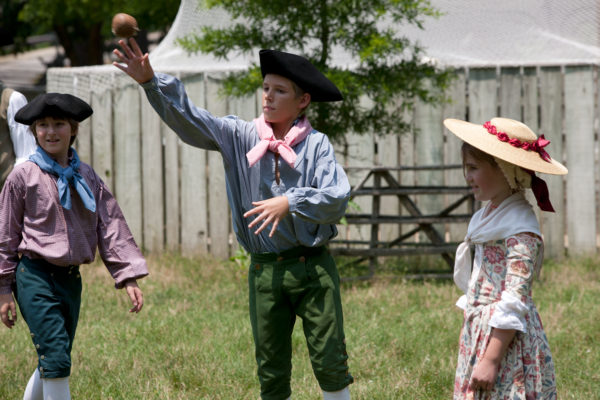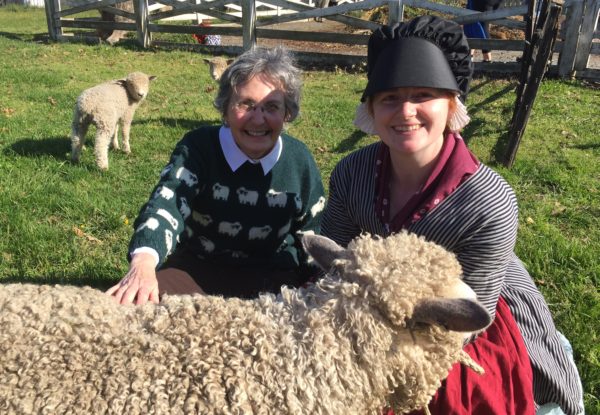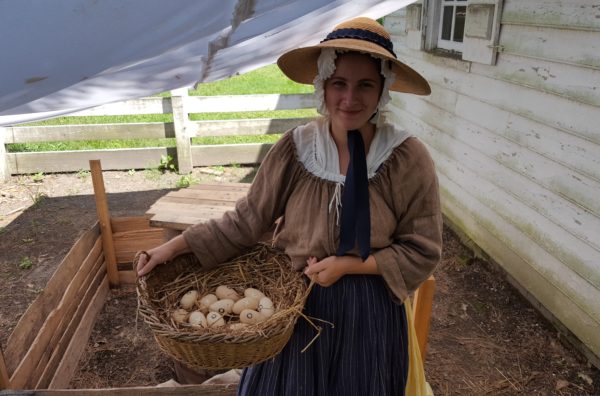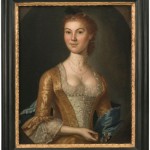
Hats were more ubiquitous in the 18th century, but much like today, they were expressions of one’s job, or one’s (often self-styled) status, or just plain personality. I decided to take a trip through town with an eye to learning more about colonial headwear. I barely scratched the surface as I discovered more variety—and fewer strict rules—than I had imagined.
Before I wandered off, Tom Hammond, one of our experts on historical apparel, schooled me on a few of the basics of covering a colonial head.
Hats were worn almost universally. Women typically wore straw; men wore felt. Since people didn’t wash as often, caps served the practical purpose of keeping greasy hair away from your face, not to mention any nearby fires.
Most men wore some variety of cocked hats—folded in various ways, often with a cockade or other ornamentation, such as expensive ostrich plumes from Africa. They weren’t actually called tricorn hats until the 19th century.
Cocked hats, Tom explained, developed so a man could hold his hat underneath his arm without crushing the brim. If a brim became worn or damaged, it could be cut down. And while society didn’t regard a person as fully dressed without a hat, the only people who were required to wear them were servants in livery and men in the military.
Military hats were cocked on just one side to accommodate carrying a weapon. Wouldn’t do to keep knocking your hat off with your gun.
Seth’s single-cocked hat is the one you’ll see militia or riflemen wearing to drill. This has a good brim that keeps the sun out of your eyes. If you see a hat like this, it’s probably a military man.
Cockades were pretty common, but more often than not they were there for decoration. White pieces of paper or cloth, for example, symbolized the American alliance with the French. But black was used to identify soldiers in the Continental Army… and the British Army. In other words, sometimes the cockade meant something; just as often it didn’t.
Civilians wore a wide variety of caps, especially when they were working. A laborer might have gone with a simple linen work cap, wool in colder weather. Sometimes they were tarred on the outside for waterproofing.
As preacher Gowan Pamphlet, James Ingram typically wears a flat black hat, which reflects the simplicity that 18th-century Baptists valued. “This is kind of hat worn by religious Dissenters—Baptists, Quakers, Methodists, Presbyterians—to distinguish themselves.” He explains that Dissenters operated in three colors: black, brown, or gray. The plainness was a sign of humility. But he doesn’t like the brim to cover his face too much. “You want the congregation to be able to see your face, to relate to you by seeing your emotion.”
At Great Hopes Plantation, the farmers wear basic round-brimmed straw hats. Ed has been breaking in a hat that usually hangs in one of the cabins to get the new look off of it. He holds it up next to his own, which is bleached nearly white in many places. The fading signifies many days’ hard work, and the need to hold up against the unforgiving Virginia sun.
Brandon’s hat is pretty weathered, too, but it stands out because of the individual touch he’s added. There’s a feather in his hat, but it has nothing to do with Yankee Doodle or Chicken George from Roots, as some have surmised.
It’s actually a tribute to Big Boy, a favorite rooster at the farm who lost his final battle with a nighttime predator a few months ago—but not without a fight. He was a perfect rooster, says Brandon. “He was like your grandfather: he might be old, he might have a pot belly, but he still knows more than you. King [one of the other roosters] would try to usurp him, but he had the hens.”
I asked Da-Veia, a colleague stationed near the Public Armoury, about her head covering, a stunning burnt-orange head wrap. She said she had just acquired it a couple of weeks ago after getting new braids in her hair. The wrap does a better job hiding them than the cap she was wearing previously, and is appropriate for an African American woman in 18th-century Williamsburg. She picked out the color, and our Costume Design Center cut the material to the right size and shape. Da-Veia dismantled the wrap so I could see how she tied it, explaining that it was similar to a scarf she often wears.
In the 18th century, men and women alike purchased hats from the milliner. The shop also trimmed hats and made caps and bonnets. I stopped at the Millinery to find out more about women’s hats in particular.
Sarah quickly disabused me of the notion that hats were a key indicator of social rank. “It’s easier to tell what someone is dressed for that their social class. You could mistake a master of the house because he’s dressed in his work clothes.” In other words, most people dressed for the occasion.
Sarah made the cap she is wearing, a winged style inspired by a French nightcap, a fashion she dates to 1777. It’s made from Irish linen. Other common fabrics were Holland, cambric, muslin, and cotton and silk gauzes. She calls the mob cap, which ties under the chin, the “the anti-vanity cap,” worn by women at work, Quaker women, and, well, older ladies. “A cap or hat is a great way to update your wardrobe quickly. Each season there are several different cap styles that are described in ladies’ magazines.”
Fiona was sitting in the window working on covering a hat in silk. Her cap is a frillier number based on a style dating from 1778-79. Hers also has the obligatory decorative ribbon on the front.
Women wore caps to keep hair up and away, and often wore fashionable straw hats over the caps when they were out. And the fashions changed quite frequently, as often as every couple of months. Letters and other reports of the latest London styles quickly made their way to the colonies, which would pick up on the trends. Virginia would lag behind a bit, of course, but not by as much as you might think. And while many people might not have the means or inclination to quickly pick up the latest fashions, that doesn’t mean they weren’t aware of them.

A black silk bonnet was a common utilitarian style, especially for women working on farms or in a dirtier environment, like a blacksmith shop. It would be cut in a fashionable way but with a cheap strong fabric that would wear well and wouldn’t show much dirt. You’ll see several women who work in Historic trades wearing the black bonnet.
When women went out, they would typically put on a bonnet or straw hat, leaving the cap underneath. The straw hat is tied in back (not under the chin). A hat pin was useful for keeping it in place. “The tension between the front of the forehead and the back of the head keeps the hat on. It’s nice to have extra security with a hat pin.” Make sure your hair is piled as tall as it can be. The hat will sit at an angle when it’s tied in back.
The trim and decoration was a key to keeping up with the fashion. Many people would just pin the trim on, making it easy to adjust to changing tastes.
Occasionally, though, there were shifts from skinny jeans to bell bottoms. In the early 1770s the hat sizes—the brims and the crowns—were small. Later in the decade, bigger hair became more fashionable, and, perhaps necessarily, so did larger hats.
My conversation with Sarah helped me understand why I found such variety in Historic Area hats. So next time you’re in town, ask an interpreter about their hat. There’s bound to be a story. And if you’re inspired, step into Mary Dickinson’s Shop, where you can deck out a straw hat with ribbon, or add a cockade to your cocked hat. And take Sarah’s advice: pin the trim on, play with an 18th-century look. After all, she says, “fashion should be fun.”
Thanks to Fred Blystone for contributing the gallery at the end!


Well written to connect with today’s apparel industry! The article illustrates innovation of hats to meet a cross section of needs: 1)Weather conditions, 2)brim that does not block facial expressions for effective communication. 3)Accessories like ribbons & feathers to signify religions rank, political views, social rank etc.. Looks like they knew how to sell benefits of types of hats! Good story of meeting customer needs & trends to secure future sales! Great idea stimulator for someone wanting to update their products to stay in business. Good article for a current day salesperson ,Junior Achievement or 4-H member!!
I loved this article. So very informative.
In how Miss Da-Veia prepared her head wrap I see traces of turbans worn in Southwest Asia. Does this style have a particular cultural relevance for the young lady? Is it done in the style of a particular cultural group? Was the skill taught at Williamsburg, or did Miss Da-Veia bring the knowledge with her? I volunteer at a National Park Site which is part of the Gullah-Geechee Cultural Heritage Corridor, and it is hard to find trustworthy information on the dress of slaves. Thank you for your help.
I love hats on other people but cannot stand to wear one! Even when I was younger and had very good hair and wore it shoulder length, I could not abide a hat. Now I wear my hair short and hats look just awful on me! I do Civil War living history, so must wear something on my head. I prefer day caps, but if I am to be outside, I wear a straw hat. because I don’t like bonnets. That of course means I must explain why my hair is short. During illness in the Civil War sometimes forces women to cut their hair. I go with the “I’ was ill for a long time and now my hair is growing back in”. that seems to work.
Jeannine, Fully understand your non-hat wearing. Short hair definitely leads to interesting tales when explain why in the interpretation. I had short for years and then did grow it out and keep it up as explained in this article.I too wore many in my various duties as a Civil War civilian impression and now doing 2nd Seminole here in Florida. I ADORE hats , but they don’t me. I gave up caring about “how looked in one” as we both know, they aren’t for everyone. Though I m very partial to my Amish farmer’s straw hat . Looking forward to trying on and possibly buying a few tri corns and ladies caps and flat straw hats..